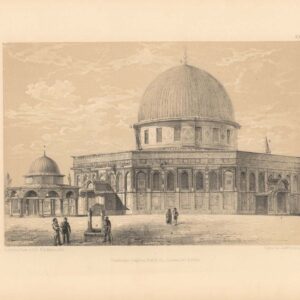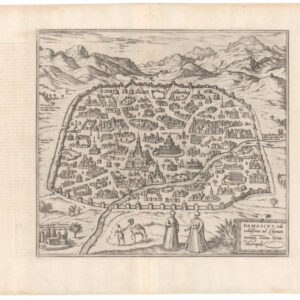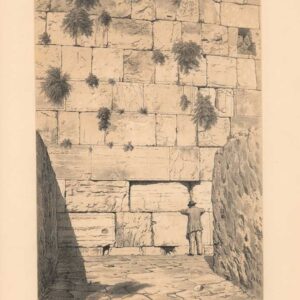Jan Luyken’s dramatic visualization of Ancient Jerusalem, likely produced for the Mortier Bible.
[Jerusalem Drawing]
$2,400
In stock
Description
This little gem by the famous Dutch illustrator and engraver Jan Luyken was created during the final years of the tumultuous 17th century at the height of Luyken’s career. It was executed in pen and black ink, and the artist uses both grey-washing and highlighting in pure white to enhance the emotional impact of his composition.
The motif is a highly stylized rendition of ancient Jerusalem, and the drama of the moment is palpably evident. Standing on a raised vantage point, one looks across the Holy City. Despite being rich in detail, most of these are quickly revealed as figments of Luyken’s vivid imagination and profound religiosity. Luyken was generally known for producing historical and religious images that exuded fervor and zeal. This particular image was most likely part of a broader commission. The best explanation is that it was compiled as a study for the engravings that Luyken produced for the Mortier Bible, published in 1700.
We see a walled square within which Jerusalem is laid out as a circular city, where all roads lead to a central elevated rock. This rock is undoubtedly a representation of Calvary and the Holy Sepulchre. A holy light emanates from this central feature, revealing it as an earthly interstice with the Divine. Nine gates pierce the curtain wall and lead to a spacious interior where only about a third of the available space has been built up. Looking down from an elevated rock promontory outside the city, we find two angels observing the city in the upper right corner of the image.
This document is a unique piece of historical art, a landscape drawing marked by the urgency and intensity of Luyken’s religious fervor.
Cartographer(s):
Jan Luyken (1649-1712) was a Dutch poet, illustrator, and engraver. Born in Amsterdam, he learned engraving from his father, Kaspar Luyken. At the age of 19, he married and fathered several children (including the famous engraver Kasparus Luiken). When he turned 26, Luyken converted to the Mennonite church, inspiring him to write moral poetry.
Luyken is probably best known for his innate ability to recreate historical periods and settings in his art. Among his most notable contributions were the illustrations for the 1685 edition of The Martyr’s Mirror, to which he contributed 104 copper etchings (although only thirty of these plates have survived). In 1694, Luyken published “Het Menselyk Bedryf” (“The Book of Trades”), a work that also showcased numerous engravings, this time depicting a broad variety of trades from the 17th century.
Condition Description
Wear and small areas of loss at the top and bottom margin. Repairs to the same with archival tape on the verso.
References



![[ALEPPO] Toi qui te plains de l’infortune, Lève-toi et va vers… ALEP… Comme le malade épuisé. Soupire après la guérison.](https://neatlinemaps.com/wp-content/uploads/2024/05/NL-01445-cover_thumbnail-300x300.jpg)